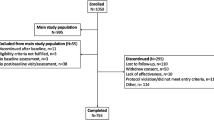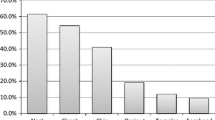Objectives. To assess the severity of pain syndrome, emotional status, and quantitative levels of humoral serotonin in patients with cervical dystonia (CD) before and after botulinum therapy. Materials and methods. A simple open comparative study of the clinical characteristics of hyperkinesia, pain, and emotional status, quality of life, and serum and platelet serotonin levels was conducted in 48 patients with cervical dystonia at age 37–53 years before and one month after botulinum therapy with botulinum toxin A (Dysport) at doses of 500–1000 U. The control group consisted of 15 healthy subjects. Results. All patients presented with complaints of involuntary movements and neck pain. The overall indicator on the dystonic movements scale among the patients was 16.7 ± 7.7 points and the score on the TWSTRS scale was 46.48 ± 6.2 points; the mean visual analog pain score was 6.4 ± 1.08 points. The levels of depression and anxiety on the Hamilton scale were significantly greater in the patients group than in the controls. The levels of reactive and trait anxiety on the Spielberger–Hanin test in patients with CD were significantly (p < 0.005) greater than those in the healthy group. Correlation analysis identified a direct relationship between pain intensity on the TWSTRS scale and the level of anxiety on the Hamilton scale and the total points score for dystonic movements. Serum and platelet serotonin levels were significantly lower than in controls. After botulinum therapy, patients showed significant reductions in pain, anxiety, and depression, while platelet serotonin increased. Conclusions. Botulinum therapy with Dysport decreased the levels of pain and depression in patients with CD, improved quality of life, and stimulated the serotoninergic system.
Similar content being viewed by others
References
V. L. Golubev, “Clinical polymorphism and the treatment of muscle dystonia,” Zh. Nevrol. Psikhiat., 91, No. 3, 30–34 (1991).
S. L. Timerbaeva, Focal and Segmental Forms of Primary Dystonia: Clinical, Pathophysiological, and Molecular-Genetic Aspects: Dissertation for Doctorate in Medical Sciences, Moscow (2012), http://medical-diss.com/medicina/fokalnye-i-segmentarnye-formy-pervichnoy-distonii#ixzz4gP6kHFOd, acc. May 7, 2017.
V. N. Shtok, I. A. Ivanova-Smolenskaya, and O. S. Levin (eds.), Extrapyramidal Disorders: Guidelines for Diagnosis and Treatment, MEDpress-inform, Moscow (2002), http://parkinsonizm.ru/?page=91, acc. May 7, 2017.
V. L. Golubev, A. Yu. Makarov, O. R. Orlova, et al., “Clinical and electromyography characteristics of spastic torticollis,” Zh. Nevrol. Psikhiat., 95, No. 4, 40–42 (1995).
A. Albanese, F. Asmus, K. P. Bhatia, et al., “EFNS guidelines on diagnosis and treatment of primary dystonias,” Eur. J. Neurol., 18, No. 1, 5–18 (2011), https://doi.org/10.1111/j.1468-1331.2010.03042.
J. K. S. Tsui, “Cervical dystonia,” Handbook of Dystonia, J. K. S. Tsui and D. B. Calne (eds.), Marcel Dekker, New York (1995).
O. R. Orlova and H. N. Yakhno, The Use of Botox (Botulinum toxin type A) in Clinical Practice: a Guide for Physicians, The Catalog, Moscow (2000).
D. Tarsy and D. K. Simon, “Dystonia,” N. Engl. J. Med., 355, No. 8, 818–829 (2006), https://doi.org/https://doi.org/10.1056/NEJMc062570.
Y. Ben-Shlomo, L. Camfield, and T. Warner, “What are the determinants of quality of life in people with cervical dystonia?” J Neurol. Neurosurg. Psychiatry, 72, No. 5, 608–614 (2002), https://doi.org/https://doi.org/10.1136/jnnp.72.5.608.
I. A. Ivanova-Smolenskaya, E. D. Markova, and S. N. Illarioshkin, “Monogenic inheritance of nervous system disease,” in: Inherited Diseases of the Nervous System, Yu. E. Vel’tishchev and P. A. Temin (eds.). Meditsina, Moscow (1998).
T. Etgen, M. Mühlau, C. Gaser, and D. Sander, “Bilateral grey-matter increase in the putamen in primary blepharospasm,” J Neurol. Neurosurg. Psychiatry, 77, No. 9, 1017–1020 (2006), https://doi.org/https://doi.org/10.1136/jnnp.2005.087148.
D. Martino, A. Di Giorgio, and E. D’Ambrosio, et al., “Cortical gray matter changes in primary blepharospasm: A voxel-based morphometry study,” Mov. Disord., 26, No. 10, 1907–1912 (2011), https://doi.org/10.1002/mds.23724.
O. N. Shcherskaya, Spastic Torticollis (clinical pathogenetic and social aspects): Dissertation for Master’s Degree in Medical Sciences, Moscow (1996), http://medical-diss.com/medicina/spasticheskayakrivosheya, acc. May 7, 2017.
O. R. Orlova, S. L. Timerbaeva, S. E. Khat’kova, et al., “Focal dystonias and their treatment with Dysport (botulinum toxin type A),” Zh. Nevrol. Psikhiat., 112, No. 5, 81–89 (2012).
M. Jahanshahi, “Factors that ameliorate or aggravate spasmodic torticollis,” J Neurol. Neurosurg. Psychiatry, 68, No. 2, 227–229 (2000), https://doi.org/10.1136/jnnp.68.2.227.
Yu. V. Karakulova, “The pathogenetic mechanisms of tension headache,” Zh. Nevrol. Psikhiat., 106, No. 7, 52–56 (2006).
J. Jancovic, S. Leder, and D. Warner, “Cervical dystonia: Clinical findings and associated movement disorders,” Neurology, 41, 1088–1091 (1991).
Z. A. Zalyalova and D. M. Abdulgalimova, “Pain syndrome before and after the use of Dysport in patients with spastic torticollis,” Zh. Nevrol. Psikhiat., 110, No. 11, 62–65 (2010).
M. Hallett, R. Benecke, A. Blitzer, and C. L. Comella, “Treatment of focal dystonias with botulinum neurotoxin,” Toxicon, 54, No. 5, 628–633 (2009), https://doi.org/10.1016/j.toxicon.2008.12.008.
A. Berardelli, J. C. Rothwell, and M. Hallett, “The pathophysiology of primary dystonia,” Brain, 121, 1195–1212 (1998), https://www.ncbi.nlm.nih.gov/pubmed/9679773, acc. May 7, 2017.
Author information
Authors and Affiliations
Corresponding author
Additional information
Translated from Zhurnal Nevrologii i Psikhiatrii imeni S. S. Korsakova, Vol. 117, No. 12, Iss. 1, pp. 33–36, December, 2017.
Rights and permissions
About this article
Cite this article
Karakulova, Y.V., Loginova, N.V. Efficacy of Botulinum Therapy in Correcting the Level of Pain Syndrome and Quality of Life in Patients with Cervical Dystonia. Neurosci Behav Physi 49, 271–274 (2019). https://doi.org/10.1007/s11055-019-00725-z
Published:
Issue Date:
DOI: https://doi.org/10.1007/s11055-019-00725-z




